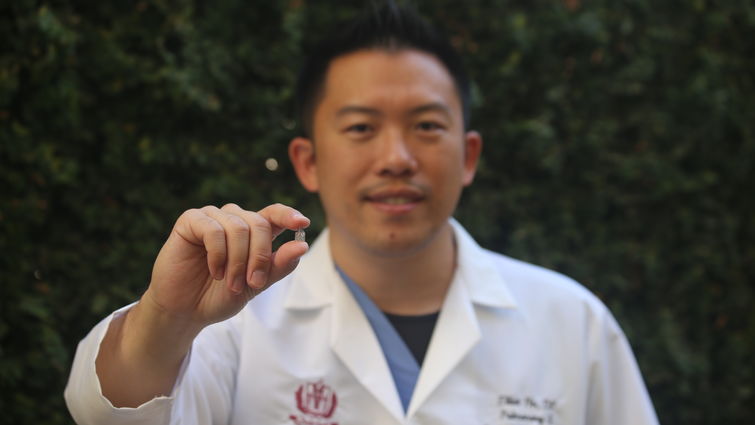Vietnam Veteran Receives Innovative Procedure From Award-Winning Pulmonology Team
September 7, 2022 | Loma Linda, California, United States | By Molly Smith, Loma Linda University Health
Chuck Park suffered at the hands of the tobacco epidemic for almost 50 years. He found renewed health from the pulmonology team at Loma Linda University Health, one of US News and World Reports’ top 50 nationally ranked pulmonology services.
Park began smoking cigarettes in the 1960s during the Vietnam War when he enlisted with the Air Force. The habit negatively affected his health for years. He eventually developed severe emphysema, a condition in which lungs are damaged, leading to hyperinflated lungs. Park’s condition caused breathlessness and slowed him down, forcing him to stop doing things he loved like riding his bike and playing tennis.

Dr. Elliot Ho displays the tiny valves that assist the minimally invasive alternate to lung volume reduction surgery. [Photo: Loma Linda University Health]
The BLVR procedure is a minimally invasive alternative to traditional lung volume reduction surgery (LVRS). During LVRS, surgeons resect diseased portions of the lung to reduce the size of overinflated lungs, allowing for expansion of the remaining lung. In BLVR, interventional pulmonologists place tiny, one-way valves in the airways of the hyperinflated emphysematous sections of the lungs. The valves prevent air from entering diseased areas, but allow trapped air to escape, achieving the same result of reducing the size of overinflated lungs without the risks of surgery and the time of recovery typical of surgery.
Ho says the minimally invasive BLVR option limits complications that are often present during surgery like a large incision site, infection, or risk of death. Ho prioritizes sharing risks and expectations with patients and their loved ones before performing the procedure.
Ho says one of the risks of the BLVR is a pneumothorax, a punctured lung, that occurs in 1 of 3 patients. This is because while the procedure shrinks down the hyperinflated lung, the other lung compensates by expanding. If the expansion occurs too quickly, this may lead to a pneumothorax. “A pneumothorax occurs because we are changing the physiology of hyperinflation over hours, when the emphysema had developed over years,” Ho says.
For this reason, Ho monitors patients for 72 hours after the procedure in the event of complications. Patients with pneumothorax after BLVR who are treated immediately have the same long-term success rates as those without a pneumothorax. “The success rates after this complication are not surprising. Having a pneumothorax indicates that the procedure is successfully shrinking down the hyperinflated lung,” he says.
Three days after being discharged, Park was on his feet again when he had “the biggest sneeze of his life.” He knew something was wrong and went to the hospital where he received a chest tube, was monitored for a couple of days, and was discharged once again.
Ho says Park’s pneumothorax was unfortunate but feels his case displays exactly what can be expected from the groundbreaking procedure. “The best part is that he is only going to continue to see positive results,” Ho says.
To learn more about the award-winning team and the services offered visit the Interventional Pulmonology website. Ask your primary care doctor for a referral to learn more about the BLVR procedure.